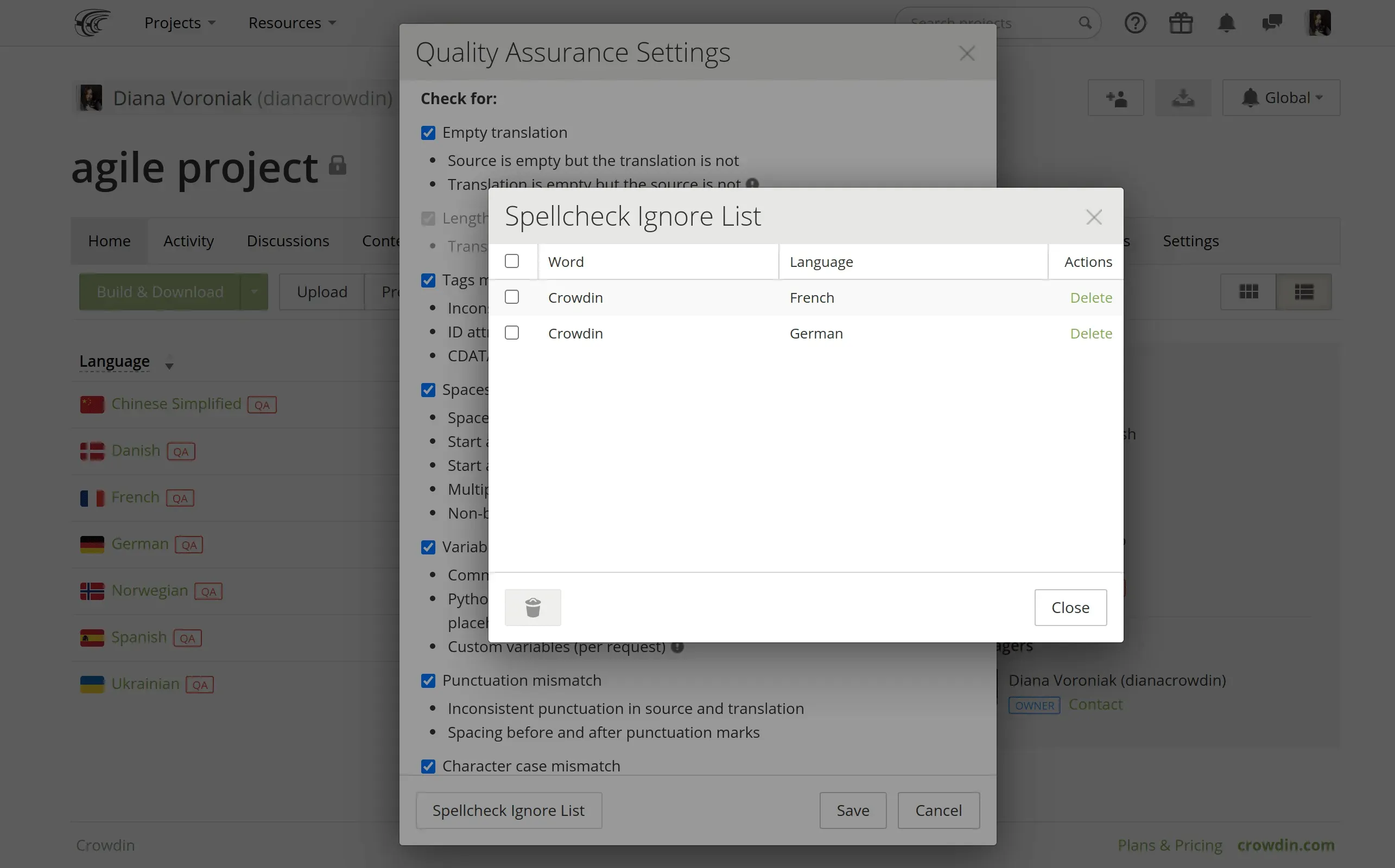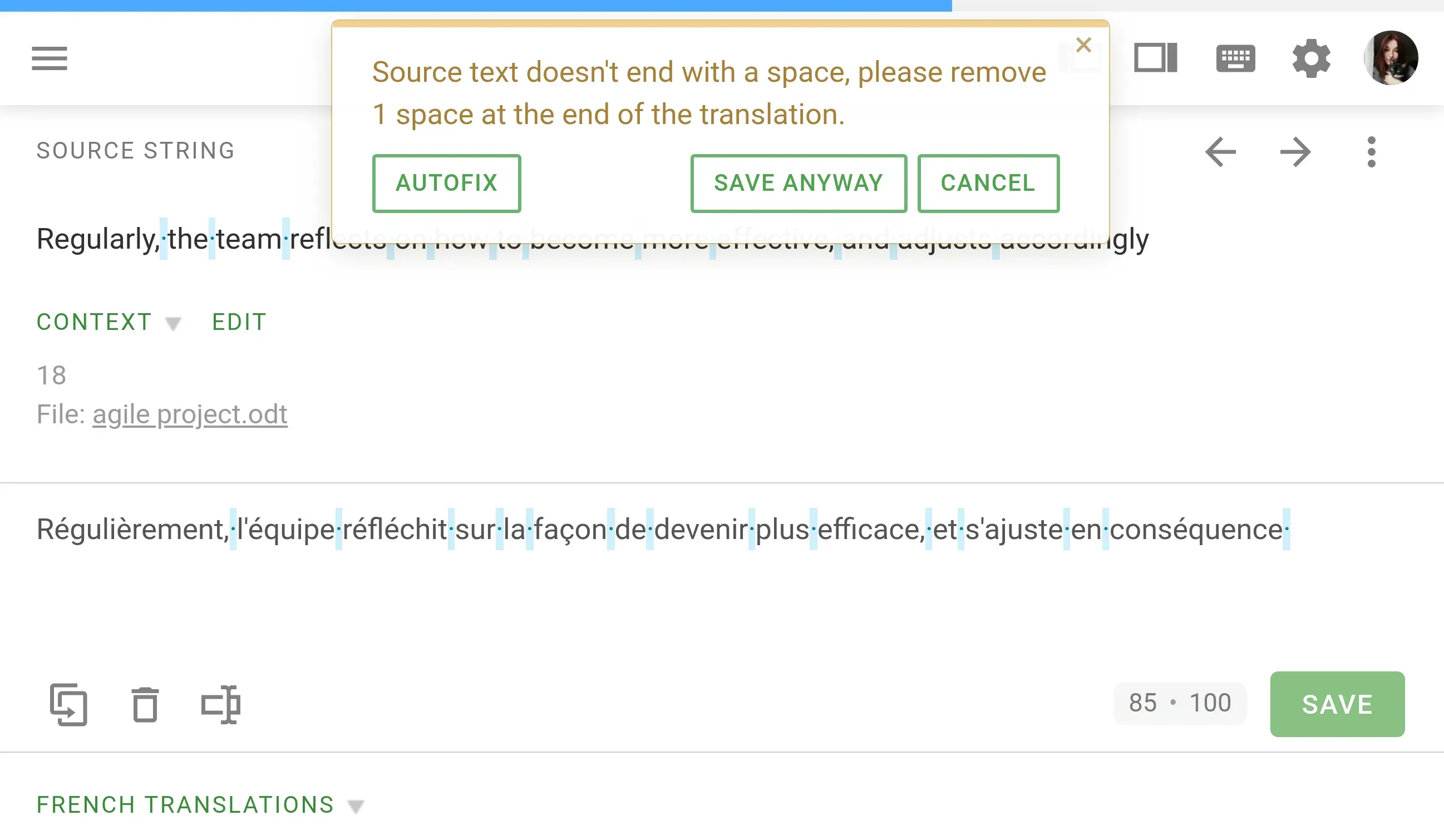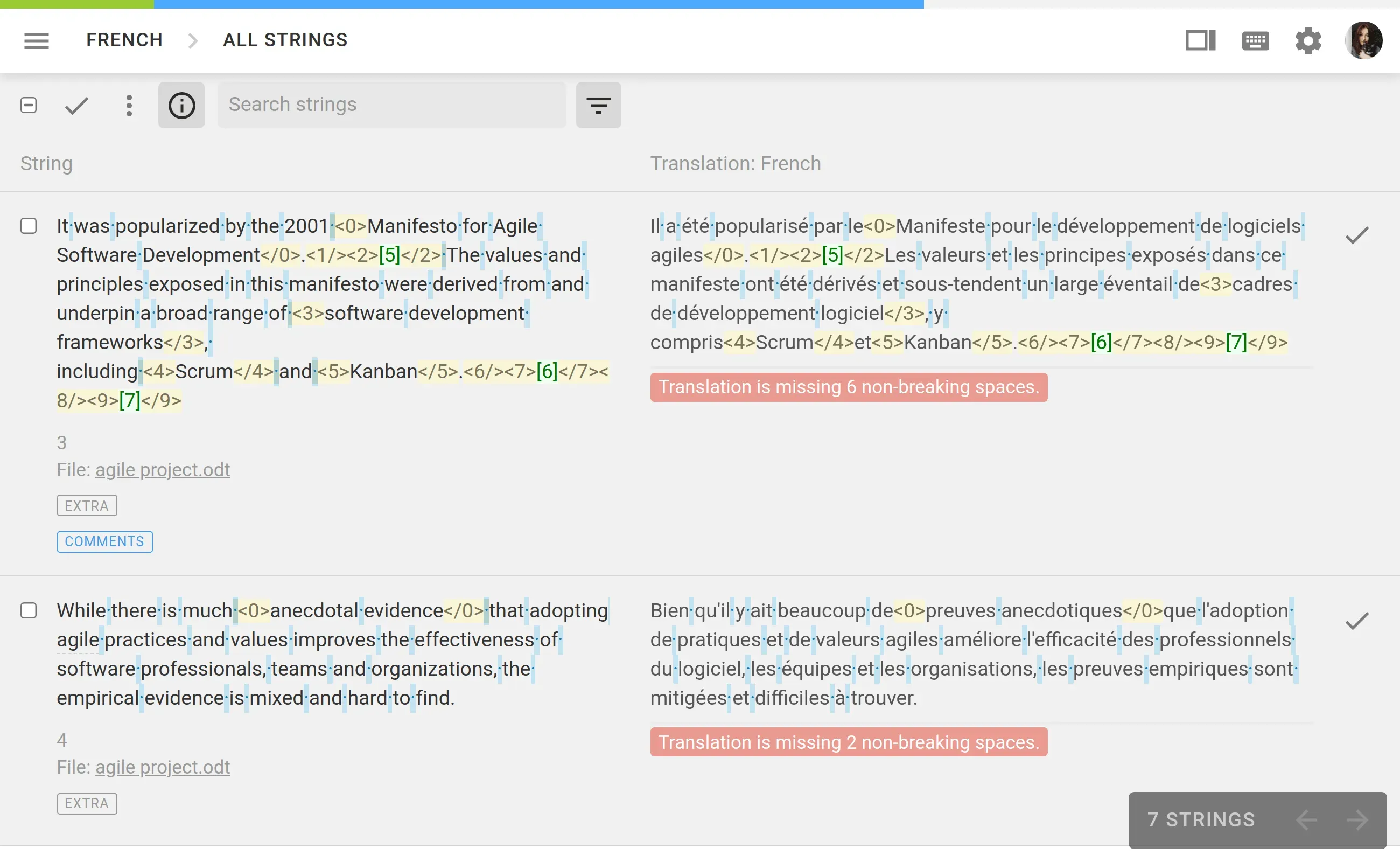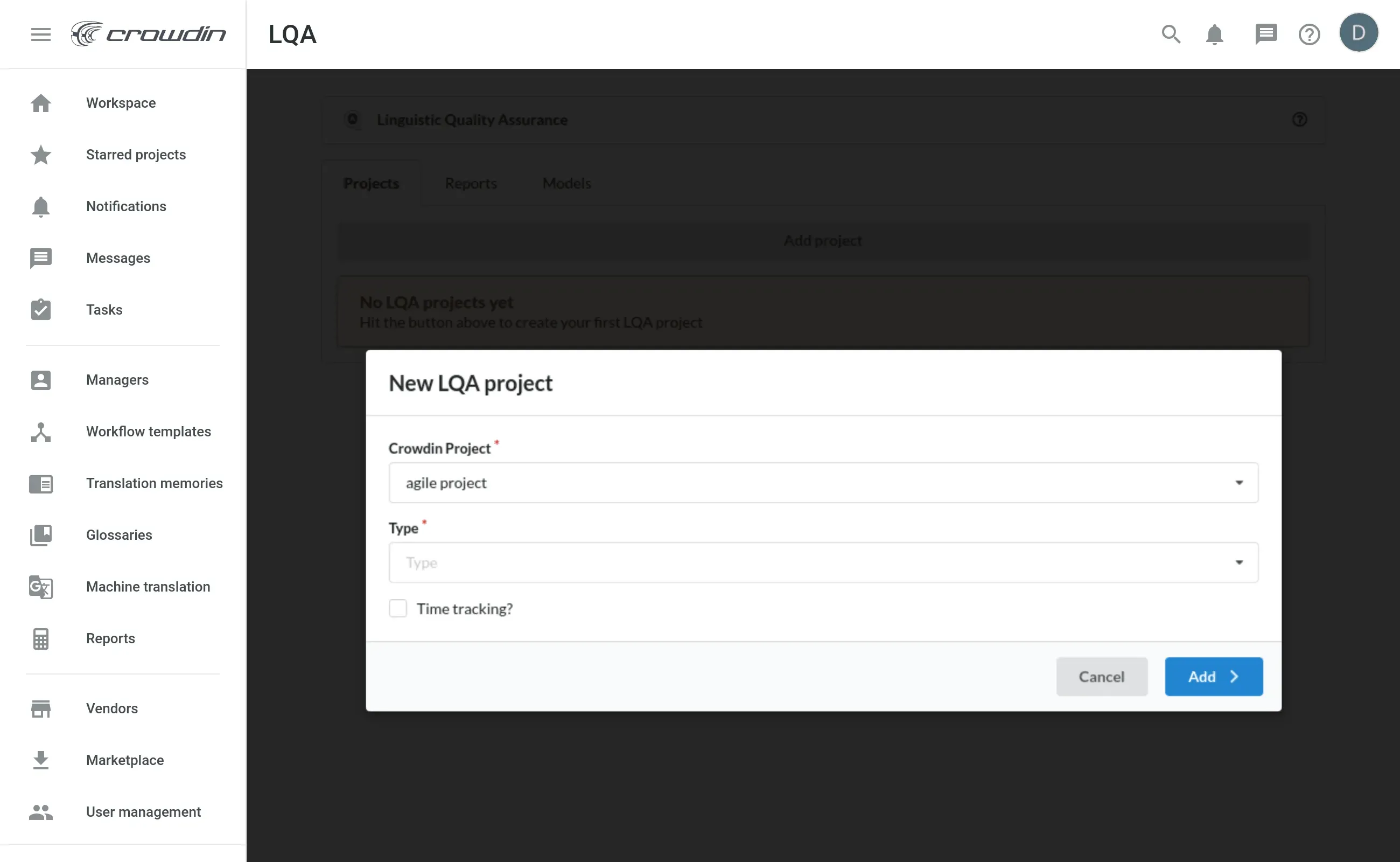Quality translation is fundamental. Translation errors, however small, can have a big impact on your product’s success. Low-quality translations can negatively impact your relationships with clients and your company’s reputation. Setting up the initial translation quality checks in Crowdin takes little time at the start and saves you time later.
What Is Language Quality Assurance
Many industries, including localization, consider quality assurance an essential step for obtaining a high-quality product. The main aim of language quality assurance (LQA) is to help you deliver accurate, clear, and error-free translations.
To get better translation results, LQA should be performed both by a linguist and by automated quality assurance checks.
What are QA Checks
The goal of translation quality checks is to identify errors made during the translation process. Some typical QA checks highlight things like missed commas, extra spaces, or typos to achieve quality in translation.
It is also possible to run checks for missing terminology, inconsistent translations, or even broken placeholders that are difficult to detect or that will be visible already on production and reported by your customers. And nobody wants to receive reports on bad translations from their customers. With the help of QA checks, you can ensure that translations will be formatted the same way as the source strings and will fit the UI just as well.
Running QA checks throughout a translation process will not only help you resolve quality issues quickly but also stop errors from being carried over from previous projects or workflow steps.
How to Evaluate Translation Quality?
Assessing a translation’s quality is essential to ensure that communication comes across accurately and effectively in different languages. There are a few things you should take into account when gauging the quality of translations.
First and foremost, linguistic accuracy and fluency play a huge role. A high-quality translation should convey the source text’s meaning, tone, and nuances while adhering to proper grammar and syntax in the target language.
Consistency is another key factor. Keeping the terminology and style consistent throughout the translated content goes a long way in making it readable and professional. Feedback from native speakers and subject matter experts can provide invaluable insights into the accuracy and effectiveness of the translation.
How to Elevate the Translation Quality
Providing context improves the translation quality.
Translators can best adapt translations to the target language when they have access to information about the subject matter, target audience, intended tone, cultural references, and any industry-specific terminology.
Terminology
Provide your team with the glossary, including a list of terms, phrases, and expressions specific to your industry, product, or brand.
Style guide
You can add the link to your style guide to the project description. Style guides typically include info on the preferred spelling, tone of voice, and other writing style nuances.
Feedback Mechanism
Provide a way for the translator to ask questions or seek clarification during translation. Comment sections in the online editor are a huge help since translators can talk to each other or point out some errors in the source text, lack of context, and other things needed to make the best translation.
WYSIWYG editor
What you see in the editor is similar to what you will know when the content is published or displayed. It’s especially helpful when translating emails, help center articles and other content where reviewing the whole page together is essential, not as a separate text.
Screenshots
Upload screenshots to the project, so translators can understand where the text will be used.
In-context
The in-context feature allows previewing of the source page and translations in real-time. This allows translators to see how the translated text will be shown on buttons, menu items, and other web page elements.
Translation Memory
TM database stores segments of previously translated text, such as sentences, phrases, or individual words. This stored information can then be reused in future translations, but it’s always important to remember that the same message can be translated differently depending on the context.
How can QA checks prevent errors in translations?
Quality Assurance (QA) checks help identify and prevent translation errors.
Consistency Verification
Compare the translated content with previously established terminology. This helps maintain consistent terminology and style across all translated materials, reducing the likelihood of errors due to inconsistent usage.
Grammar and Syntax Review
QA processes include grammar, syntax, and punctuation reviews. This helps identify and correct grammatical errors, sentence structure, and other language-related mistakes.
Spelling Errors
QA checks detect and correct spelling errors that might have been missed during the initial translation phase.
Feedback Loop
QA processes often involve translators, proofreaders, and reviewers collaborating. This collaborative approach allows for a feedback loop where potential errors or discrepancies can be identified and rectified before the final translation is delivered.
How do QA checks work in Crowdin?
With QA checks, you can ensure the quality of translations by helping translators and proofreaders detect some common mistakes easily and quickly. In Crowdin, QA checks are enabled for each project by default, to configure them, you can go to the project’s home page > QA.
Currently, on Crowdin, you can check for:
- length issues
- empty translations
- spaces mismatch
- character case mismatch
- tags mismatch
- variables mismatch
- spelling
- punctuation mismatch
- special character mismatch
- ’’incorrect translation’’ issues
- consistent terminology
- ICU syntax
- duplicate translation
- FTL syntax
Read more about each QA check parameter.
The essential QA checks like length issues, ICU syntax errors, duplicate translation, and FTL syntax errors are enabled for each project by default and can’t be disabled.

In the QA configuration dialogue, you can also find the Spellcheck Ignore List. It is helpful in cases when your project contains words that the spell-checker cannot recognize. For example, your brand name and some other terminology that is uncommon and can be highlighted by the spellcheck. You can add them to the Ignore list to exclude them from being highlighted like an issue. You’ll also be able to add words to the ignore list when reviewing translations in the editor once you see some of them highlighted by the QA check.

Localize your product with Crowdin
Notify Translators of Possible Mistakes
Once the manager enables QA checks on the project page, translators will receive an automated warning message every time they try to save a string with unresolved issues.

Remember that translators won’t receive any warnings if they disable QA issues in the Editor Settings.

If translators choose to save the string anyway, they will still see QA issues under the saved translation in the editor.

Show Proofreaders Strings that Require Additional Attention
Proofreaders usually work In the Side-by-Side mode in Crowdin. Here they can review, edit, and approve translations. If translators saved strings with QA issues on the previous stages, proofreaders would see them here. Issues are described right below the translations and highlighted in red.

It’s recommended to review and resolve all QA issues before downloading and using translations on production.
Read more about QA checks in Crowdin.
Quality Assurance Checks in Crowdin Enterprise
Along with the same list of QA checks and the Ignore list, you can also find custom QA checks and the LQA app that are available only in Crowdin Enterprise.
Custom QA Checks
On Crowdin Enterprise, you can add specific QA checks like a color mismatch, emoji mismatch, or a custom one depending on your project specifics.
This feature is called custom QA checks and is available for Crowdin Enterprise users only. You can manage it in the Organization Settings > QA Checks.
For instance, you can configure a QA check to verify the length of each translation in pixels to make sure that translations will fit the UI perfectly. It is opposed to the max character QA check and keeps control over the multiple fonts that could vary between the target languages. When working with different alphabets, you need to remember that the width of each one could be quite different (French and Chinese, for example). This way, you can be completely sure that both character limits and pixel limits will be preserved.
For more details, read our article about custom QA checks to learn how to create and enable them. Contact our support team if you need extra help working with custom QA Checks or have any questions.
 Linguistic Quality Assurance App
Linguistic Quality Assurance App
The Linguistic Quality Assurance app helps you track the quality, productivity, and efficiency of translation with industry-standard metrics. The app allows you to apply different proofreading work types.
You can choose from:
- TAUS DQF-MQM Model
- LISA Model
- SAE J2450 Model
- Rating
Alternatively, you can modify the existing models and create your own one if you want to apply other criteria for measuring the quality of translations.

Read more about setting up the Linguistic Quality Assurance app and learn how it helps with quality evaluation.
Time tracking with the LQA app
TheLinguistic Quality Assurance app also offers time tracking. The option is useful for those who prefer hourly payment rather than paying by the number of words checked. It allows you to track how much time was spent on a string. You can find this information in the LQA report.

Crowdin Support Services
If you are interested in custom QA checks created by our team, you can request custom development. Crowdin also offers additional support services like on-demand tutorials, onboarding sessions, and technical assistance.
During the trial period and the first month of the subscription, onboarding calls are included. After that, you can sign up for a monthly subscription or get additional calls as add-ons.
You can contact our sales team to find out more.
What Is Linguistic Quality Assurance
Many industries, including localization, consider quality assurance an essential step for obtaining a high-quality product. Language quality assurance (LQA) aims to help you deliver accurate, clear, and error-free translations. To get better translation results, LQA standards should be achieved both by a linguist and by automated quality assurance checks.
Try Crowdin Enterprise
A personal demo is the best way to learn best practices and the ways to localize your product and other content with Crowdin. You can use Crowdin Enterprise not only to monitor the quality of translations better but also to configure your own workflows to automate and speed up localization. Request a demo, and in 30-60 minutes, you will get a personalized consultation on how to use the product to get the best results and expand to new markets.
Localize your product with Crowdin Enterprise
Diana Voroniak
Diana Voroniak has been in the localization industry for over 4 years and currently leads a marketing team at Crowdin. She brings a unique perspective to the localization with her background as a translator. Her professional focus is on driving strategic growth through content, SEO, partnerships, and international events. She celebrates milestones, redesigns platforms, and spoils her dog and cat.
